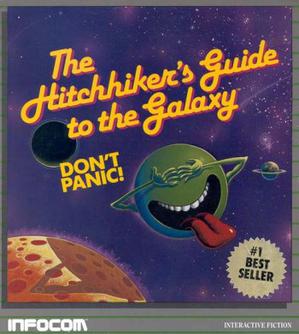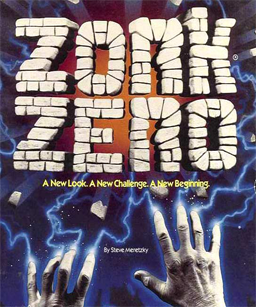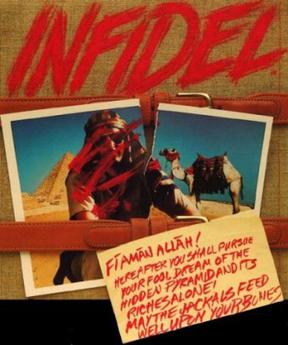Related Research Articles
Infocom was an American software company based in Cambridge, Massachusetts, that produced numerous works of interactive fiction. They also produced a business application, a relational database called Cornerstone.
Interactive fiction, often abbreviated IF, is software simulating environments in which players use text commands to control characters and influence the environment. Works in this form can be understood as literary narratives, either in the form of Interactive narratives or Interactive narrations. These works can also be understood as a form of video game, either in the form of an adventure game or role-playing game. In common usage, the term refers to text adventures, a type of adventure game where the entire interface can be "text-only", however, graphical text adventure games, where the text is accompanied by graphics still fall under the text adventure category if the main way to interact with the game is by typing text. Some users of the term distinguish between interactive fiction, known as "Puzzle-free", that focuses on narrative, and "text adventures" that focus on puzzles.

Zork is a text adventure game first released in 1977 by developers Tim Anderson, Marc Blank, Bruce Daniels, and Dave Lebling for the PDP-10 mainframe computer. The original developers and others, as the company Infocom, expanded and split the game into three titles—Zork I: The Great Underground Empire, Zork II: The Wizard of Frobozz, and Zork III: The Dungeon Master—which were released commercially for a range of personal computers beginning in 1980. In Zork, the player explores the abandoned Great Underground Empire in search of treasure. The player moves between the game's hundreds of locations and interacts with objects by typing commands in natural language that the game interprets. The program acts as a narrator, describing the player's location and the results of the player's commands. It has been described as the most famous piece of interactive fiction.

The Hitchhiker's Guide to the Galaxy is an interactive fiction video game based on the comedic science fiction series of the same name. It was designed by series creator Douglas Adams and Infocom's Steve Meretzky, and it was first released in 1984 for the Apple II, Mac, Commodore 64, CP/M, MS-DOS, Amiga, Atari 8-bit computers, and Atari ST. It is Infocom's fourteenth game.
The decoder pen, yes-no pen, yes-know pen or magic pen book is a combination of decoder pen or marker specially designed to reveal invisible ink-encoded pictures or writing, in the form of answers to questions or hidden parts of pictures, with specially created children's books with hidden words and pictures. They were most popular in the 1970s, but continue to be sold at gift shops. Often they were in the form of trivia games, which enabled the player to guess before revealing the answer. Brands of books for use with decoder pens include Yes & Know, and surprise Ink.

Leather Goddesses of Phobos is an interactive fiction video game written by Steve Meretzky and published by Infocom in 1986. It was released for the Amiga, Amstrad CPC, Amstrad PCW, Apple II, Mac, Atari 8-bit computers, Atari ST, Commodore 64, TI-99/4A, and MS-DOS. The game was Infocom's first "sex farce", including selectable gender and "naughtiness"—the latter ranging from "tame" to "lewd". It was one of five top-selling Infocom titles to be re-released in Solid Gold versions. It was Infocom's twenty-first game.

Wishbringer: The Magick Stone of Dreams is an interactive fiction video game written by Brian Moriarty and published by Infocom in 1985. It was intended to be an easier game to solve than the typical Infocom release and provide a good introduction to interactive fiction for inexperienced players, and was well received.

Planetfall is a science fiction themed interactive fiction video game written by Steve Meretzky, and published in 1983 as the eighth game from Infocom. The original release was for Apple II, Atari 8-bit computers, TRS-80, and IBM PC compatibles. Atari ST and Commodore 64 versions were released in 1985. A version for CP/M was also released. Planetfall was Meretzky's first published game, and it proved one of his most popular works and a best-seller for Infocom. It was one of five top-selling games to be re-released in Solid Gold versions with in-game hints. Planetfall uses the Z-machine originally developed for Zork and was added as a bonus to the Zork Anthology.

The Lost Treasures of Infocom is a 1991 compilation of 20 previously-released interactive fiction games developed by Infocom. It was published by Activision for MS-DOS, Macintosh, Amiga, and Apple IIGS versions. It was later re-released on CD-ROM, and in 2012 on iOS.

Beyond Zork is an interactive fiction computer game written by Brian Moriarty and released by Infocom in 1987. It was one of the last games in the Zork series developed by Infocom. It signified a notable departure from the standard format of Infocom's earlier games which relied purely on text and puzzle-solving: among other features, Beyond Zork incorporated a crude on-screen map, the use of character statistics and levels, and RPG combat elements.

Zork Zero: The Revenge of Megaboz is an interactive fiction computer game, written by Steve Meretzky over nearly 18 months and published by Infocom in 1988. Although it is the ninth and last Zork game released by Infocom before the company's closure, Zork Zero takes place before the previous eight games. Unlike its predecessors, Zork Zero is a vast game, featuring a graphical interface with scene-based colors and borders, an interactive map, menus, an in-game hints system, an interactive Encyclopedia Frobozzica, and playable graphical mini-games. The graphics were created by computer artist James Shook. It is Infocom's thirty-second game.

A scavenger hunt is a game in which the organizers prepare a list defining specific items, which the participants seek to gather or complete all items on the list, usually without purchasing them. Usually participants work in small teams, although the rules may allow individuals to participate. The goal is to be the first to complete the list or to complete the most items on that list. In variations of the game, players take photographs of listed items or be challenged to complete the tasks on the list in the most creative manner. A treasure hunt is another name for the game, but it may involve following a series of clues to find objects or a single prize in a particular order.

Infidel is an interactive fiction video game published by Infocom in 1983. It was written and designed by Michael Berlyn and Patricia Fogleman, and was the first in the "Tales of Adventure" line. It was released for the Amstrad CPC, Apple II, Atari 8-bit computers, Commodore 64, IBM PC compatibles, TRS-80, and TI-99/4A. Ports were later published for Mac, Atari ST, and Amiga. Infidel is Infocom's tenth game.

Seastalker is an interactive fiction game written by Stu Galley and Jim Lawrence and published by Infocom in 1984. It was released simultaneously for several popular computer platforms of the time, such as the Commodore 64, Apple II, and IBM PC compatibles. The game was marketed as an introduction to interactive fiction for preteen players, having difficulty rating of "Junior." It was the only game to ever use this rating, which was replaced by the "Introductory" label given to games such as Wishbringer. It is Infocom's twelfth game.

Moonmist is an interactive fiction game written by Stu Galley and Jim Lawrence and published by Infocom in 1986. The game was released simultaneously for the Amiga, Amstrad CPC, Apple II, Atari 8-bit computers, Atari ST, Commodore 64, MS-DOS, TRS-80, TI-99/4A, and Mac. It is Infocom's twenty-second game. Moonmist was re-released in Infocom's 1995 compilation The Mystery Collection, as well as the 1996 compilation Classic Text Adventure Masterpieces.

James Clavell's Shōgun is an interactive fiction video game written by Dave Lebling and published by Infocom in 1989. It was released for the Amiga, Apple II, DOS, and Macintosh. The game is based on the 1975 novel Shōgun by James Clavell. It is Infocom's thirty-third game.

Journey: The Quest Begins is an interactive fiction computer game designed by Marc Blank, with illustrations by Donald Langosy, and released by Infocom in 1989. Like the majority of Infocom's works, it was released simultaneously for several popular computer platforms, such as the Commodore 64, Apple II, and PC. Journey is unusual among Infocom games in that it could be played entirely via mouse or joystick, with no typing required. It was the thirty-fifth and last game released by Infocom before parent company Activision closed the Cambridge office, effectively reducing Infocom to a "label" to be applied to later games.
Perplex City was an alternate reality game (ARG) created by Mind Candy, a London-based developer in 2005. Adrian Hon was the producer, designer and director of the game's first and only season, in which players searched for "The Receda Cube", an artifact of spiritual significance to the inhabitants of a fictional metropolis known as "Perplex City" which had great scientific value. In the game, "The Cube" had been stolen and buried somewhere on Earth.
Classic Text Adventure Masterpieces of Infocom is a collection of 33 computer games from interactive fiction pioneer Infocom, and the top 6 winners of the 1995 Interactive Fiction Competition, released in 1996. All 39 games are combined on a single cross-platform CD-ROM, which also includes PDFs of all the Infocom games' instructions, maps, and hint booklets.
The Cipher Hunt was an alternate reality game and international scavenger hunt created by storyboard artist and voice actor Alex Hirsch based on his animated series Gravity Falls. The goal was to find the real-life statue of the series' antagonist Bill Cipher, which was briefly glimpsed at the end of the series finale. The hunt involved retrieving and decoding clues hidden in various locations worldwide.
References
- 1 2 InvisiClues Introduction Archived 2009-07-13 at the Wayback Machine from the Infocom Homepage (hosted by The University of Western Ontario)
- ↑ InvisiClues for Zork I Archived 2009-01-01 at the Wayback Machine from the Infocom Homepage
- ↑ "How can I kill the songbird?" question Archived 2006-01-12 at the Wayback Machine from the InvisiClues page from the Infocom Homepage
- ↑ Maher, Jimmy (2013-10-23). "Masters of the Game". The Digital Antiquarian. Retrieved 9 January 2015.